Artificial Gravity
One aspect of Earth’s habitable environment that we very much take for granted is the gravitational field in which our bodies evolved to function. In any environment beyond Earth’s surface, we must either adapt to differences in gravity, or find some way of negating its absence. Here we take a look at representations of artificial gravity in science fiction and the science behind them [1].
Thrust gravity
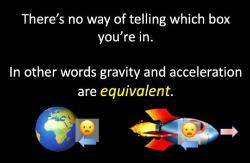 Perhaps the simplest way of simulating gravity on spaceships is rooted surprisingly deeply in our understanding of how gravity works. Einstein’s Theory of General Relativity is built on what is known as the equivalence principle: in its simplest form, this states that without external clues it is impossible to tell whether you are standing on the surface of a gravitating body or travelling in an accelerating space craft. In either case, the subject experiences an acceleration which presses them towards a surface - the same acceleration which presses us back into seats when an aeroplane takes off or throws us forward against our seat-belts when a vehicle comes to a sudden stop.
Perhaps the simplest way of simulating gravity on spaceships is rooted surprisingly deeply in our understanding of how gravity works. Einstein’s Theory of General Relativity is built on what is known as the equivalence principle: in its simplest form, this states that without external clues it is impossible to tell whether you are standing on the surface of a gravitating body or travelling in an accelerating space craft. In either case, the subject experiences an acceleration which presses them towards a surface - the same acceleration which presses us back into seats when an aeroplane takes off or throws us forward against our seat-belts when a vehicle comes to a sudden stop.
Naturally then a spacecraft which remains under acceleration during its journey will provide its crew with a gravitational force which defines “down” as pointing towards the tail of the craft, while “up” is in the direction of increasing velocity.
This long-maintained, constant acceleration thrust gravity appears frequently in SF, with examples ranging from the Hergé’s Adventures of Tintin comic book Destination Moon (comic, Hergé, 1959) to the novels of Poul Anderson (e.g. Tau Zero, 1970) and Alistair Reynolds (e.g. the lighthuggers in Redemption Ark, 2002) and the recent Expanse novels and television series. A number of science fictional vessels feature compartments which are either pivoted (so that the floor remains constant regardless of the local gravity field) or designed to be used in several different orientations. Thus when landed on a planet, the occupants use furniture which would be suspended from a wall or ceiling when the rocket is under acceleration, or vice versa.
However while constant acceleration provides a relatively straightforward replacement for gravity, it has two significant issues. First, and most problematically, constant acceleration requires the constant application of thrust. This in turn requires constant expenditure of fuel, and rapidly runs into the law of diminishing returns: to travel further or faster more fuel must be burnt, but that fuel must be carried along, requiring still more fuel to accelerate it. This leads to the famous "rocket equation" which demonstrates the unsustainability of thrust gravity. Unless fuel can be collected along the route or is itself massless, the demands rapidly become unsupportable and the acceleration cannot be maintained. In addition, constant acceleration acting forward can only be maintained for half of any journey. After that, unless the floor and ceiling are interchangeable and the vehicle constructed so that thrust applied in either direction, the ship must be “turned over” and the engines used for deceleration while apparent gravity is maintained. This is potentially a delicate and difficult manoeuvre, since the margins for error in final alignment and time of turn-over are small.
Of course, while these drawbacks are significant, SF narratives often find ways to circumvent them. As a result, Tintin’s moon rocket hosts a nuclear fission engine which requires very little fuel (although it would still need reaction mass to eject), and the Expanse’s narrative relies on the “Epstein Drive” - a fictional, highly fuel-efficient fusion propulsion system. Other alternatives such as Tau Zero include ramscoop drives, which gather reaction mass and fuel from space using magnetic nets rather than carrying fuel within the craft. While some early examples of turn-over involved rocket thrusters (as in Tintin), a more common way of changing direction exploits the properties of gyroscopes (e.g. in Journey Into Space, radio, 1953), and some craft (such as the interplanetary liners in Dan Dare: Pilot of the Future, comic, 1950) simply have bidirectional thrusters and cabin configurations instead.
Magnetic Attraction
An alternative to constant acceleration, and one requiring far less in terms of fuel supply, is the use of simple magnetic attraction. Given that the majority of spacecraft are expected to have metal deckplates, providing passengers and crew with magnetic boots provides a straightforward way for them to maintain their orientation and walk (almost) normally around the craft. At their most basic these need only be bar magnets built into the soles of strap-on overshoes, as seen in early science fiction examples such as Journey into Space or The Adventures of Tintin. Alternatively they can include more complex electromagnets, activated and deactivated on each step by the flexing of foot muscles so as to provide a more normal gait. This is seen for example in The Expanse, where an entire sequence in the episode "Assured Destruction" (2018) is dedicated to teaching an Earth politician to walk smoothly using boots on a spacecraft in free-fall.
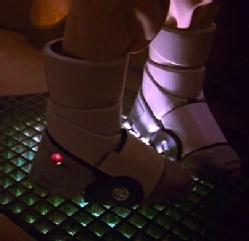 In most science fiction, however, the use of magnetic boots is restricted to a back-up measure for when alternative forms of artificial gravity fail or can not be used. In the Star Trek universe, for example, magnetic boots are seen in use when the deck gravity fails in starships, or when repairs are required on the hull of a craft, but not in everyday use. Likewise, in the Doctor Who episode “Oxygen” (TV, 2017, involving the Twelfth Doctor), magnetic boots incorporated into complex smartsuits are used by workers at the Chasm Forge space station. These suits also incorporated life support - but only if the workers have enough financial credit available.
In most science fiction, however, the use of magnetic boots is restricted to a back-up measure for when alternative forms of artificial gravity fail or can not be used. In the Star Trek universe, for example, magnetic boots are seen in use when the deck gravity fails in starships, or when repairs are required on the hull of a craft, but not in everyday use. Likewise, in the Doctor Who episode “Oxygen” (TV, 2017, involving the Twelfth Doctor), magnetic boots incorporated into complex smartsuits are used by workers at the Chasm Forge space station. These suits also incorporated life support - but only if the workers have enough financial credit available.
The restricted use of magnetic gravity in SF is perhaps unsurprising. It's also unsurprising that while magnetic boots have been proposed since the 1960s for use by astronauts, they've never been common in real-world spaceflight. While a firm footing can facilitate orientation and movement in free-fall, it cannot negate the debilitating effects of extended microgravity on the human body, including bone loss, digestive, vision and circulation problems. Simple and effective as it may be, it is not a long term solution for human habitation in space.
In a Spin
From the earliest science fiction through to today, perhaps the most plausible and widespread mechanism for creating an artificial pseudogravity in space is the exploitation of spin or centrifugal gravity.
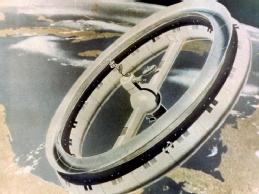 Centrifugal “force” is the perceived force that flings a rotating object outwards on its release - for example a ball swung around the head on a cord will fly away if released. It is in fact simply the manifestation of Newton’s First Law: an object naturally wants to move in a straight line rather than a circle and will continue in a line outwards if released. For a human in a spinning space station, this force will press them outwards towards the hull of the craft, allowing them to walk on its inner shell as if on the surface of a planet. By contrast, centripetal force (and its resulting acceleration) is the phenomenon preventing this outwards motion - in the case of an object swung around the body on a cord this force is provided by the tension in the string, in the case of a planet it is supplied by gravity, in the case of a rotating space station, it is provided by the wheel-like or rigid infrastructure of the station (as shown in this example from the Smithsonian Magazine).
Centrifugal “force” is the perceived force that flings a rotating object outwards on its release - for example a ball swung around the head on a cord will fly away if released. It is in fact simply the manifestation of Newton’s First Law: an object naturally wants to move in a straight line rather than a circle and will continue in a line outwards if released. For a human in a spinning space station, this force will press them outwards towards the hull of the craft, allowing them to walk on its inner shell as if on the surface of a planet. By contrast, centripetal force (and its resulting acceleration) is the phenomenon preventing this outwards motion - in the case of an object swung around the body on a cord this force is provided by the tension in the string, in the case of a planet it is supplied by gravity, in the case of a rotating space station, it is provided by the wheel-like or rigid infrastructure of the station (as shown in this example from the Smithsonian Magazine).
Because spin in a frictionless environment does not require energy to maintain (and even in the real world is fairly efficient), and because the force is felt throughout the body rather than just at the feet, this provides a plausible solution to human habitability. Spinning wheels in space can be found in science fiction and science factual speculation dating back to early work by rocket pioneers such as Wehner von Braun, with examples including the Wheel in Space of Tom Swift (Tom Swift and His Outpost in Space a.k.a. his Sky Wheel, 1955), O’Neill cylinders such as Babylon 5 (TV, 1993-1998) or Rama (Rendezvous with Rama, Clarke 1973) and the habitation rings of space stations such as Thunderbird 5 in Thunderbirds (TV, 1965-6).
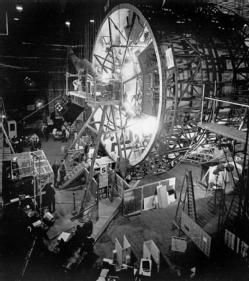 Often in the case of spacecraft, as opposed to space stations or permanent residences, only a section of the craft is seen to rotate. In the case of examples like Babylon 5 and The Expanse, this can be a large, blocky section swinging around the (non-rotating) propulsion core on an extended arm. However perhaps the most effective evocation, and technically impressive, realisation of spin-gravity on screen was in the Discovery, the spacecraft sent to Jupiter in 2001: A Space Odyssey (film 1968, dir. Kubrick; novel, 1968, Clarke). This craft was comprised largely of exposed metal gantries and large pods containing fuel, supplies and propulsion mechanisms, with a large wheel rotating around the central axis of the vessel to provide quarters for the crew. This was a relatively early representation of a space-bound vessel, never designed for landing in an atmosphere, unlike the stream-lined rockets of earlier films. The realisation of the habitation wheel was a technical feat, with a filmed sequence showing the astronaut Dave Bowman jogging around the whole circumference of the interior, past furniture and other equipment all oriented outwards from the centre of rotation. This required the construction of an entire full-scale model which was rotated around a central pivot while the camera remained fixed as this archival 1968 article from The American Cinematographer describes (see image above, sourced from the same article).
Often in the case of spacecraft, as opposed to space stations or permanent residences, only a section of the craft is seen to rotate. In the case of examples like Babylon 5 and The Expanse, this can be a large, blocky section swinging around the (non-rotating) propulsion core on an extended arm. However perhaps the most effective evocation, and technically impressive, realisation of spin-gravity on screen was in the Discovery, the spacecraft sent to Jupiter in 2001: A Space Odyssey (film 1968, dir. Kubrick; novel, 1968, Clarke). This craft was comprised largely of exposed metal gantries and large pods containing fuel, supplies and propulsion mechanisms, with a large wheel rotating around the central axis of the vessel to provide quarters for the crew. This was a relatively early representation of a space-bound vessel, never designed for landing in an atmosphere, unlike the stream-lined rockets of earlier films. The realisation of the habitation wheel was a technical feat, with a filmed sequence showing the astronaut Dave Bowman jogging around the whole circumference of the interior, past furniture and other equipment all oriented outwards from the centre of rotation. This required the construction of an entire full-scale model which was rotated around a central pivot while the camera remained fixed as this archival 1968 article from The American Cinematographer describes (see image above, sourced from the same article).
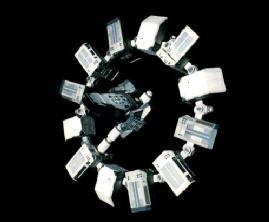 However, while spin gravity is plausible and effective, it too presents technical problems. The first is a matter of scale. Centripetal acceleration scales as the size of rotating body multiplied by the square of its angular velocity. In order to present one Earth gravity (1g), a spacecraft with a ring diameter of 76m (the length of a jumbo jet) would need to complete a full rotation every 17 and a half seconds (i.e. more than three revolutions a minute). Lower gravities require lower speeds, but their long term effect on humans remain unclear. This problem can be mitigated by making the craft larger, but even a habitation cylinder with a diameter of a kilometre (an order of magnitude larger than anything we’ve built in space) would still need to turn on its axis more than once a minute. This rapid rotation would make any docking with the craft challenging as it would have to take place on the central axis and would involve spin-matching in the approaching ship. This was seen dramatically in the 2014 film Interstellar (dir. Nolan), in which the landing shuttle docked with the exploration ship Endurance at the hub of a ring of habitation modules [2]. Spin gravity would also exert enormous tensile stresses on the material used for construction. Since these stresses are somewhat weakened by size, building larger vessels or stations would be less technically difficult, but also require substantially more construction material to be transported to the construction site - itself a huge challenge, whether that material is sourced from Earth, the Moon or the Asteroid Belt.
However, while spin gravity is plausible and effective, it too presents technical problems. The first is a matter of scale. Centripetal acceleration scales as the size of rotating body multiplied by the square of its angular velocity. In order to present one Earth gravity (1g), a spacecraft with a ring diameter of 76m (the length of a jumbo jet) would need to complete a full rotation every 17 and a half seconds (i.e. more than three revolutions a minute). Lower gravities require lower speeds, but their long term effect on humans remain unclear. This problem can be mitigated by making the craft larger, but even a habitation cylinder with a diameter of a kilometre (an order of magnitude larger than anything we’ve built in space) would still need to turn on its axis more than once a minute. This rapid rotation would make any docking with the craft challenging as it would have to take place on the central axis and would involve spin-matching in the approaching ship. This was seen dramatically in the 2014 film Interstellar (dir. Nolan), in which the landing shuttle docked with the exploration ship Endurance at the hub of a ring of habitation modules [2]. Spin gravity would also exert enormous tensile stresses on the material used for construction. Since these stresses are somewhat weakened by size, building larger vessels or stations would be less technically difficult, but also require substantially more construction material to be transported to the construction site - itself a huge challenge, whether that material is sourced from Earth, the Moon or the Asteroid Belt.
An interesting compromise implementation of spin gravity can be seen in the 2015 novel SevenEves by Neil Stephenson. Here, an emergency effort to create human habitation in space led to the creation both of a torus (spinning wheel) for mounting on the International Space Station, and also of Arklets - autonomously moving craft which, while individually small, could be paired and connected by a long cord to rotate around their common centre of mass, like the weights on a dumbell or bolas. Indeed the name adopted for such a configuration was a Bola, with more complex triads and heptads made possible by the addition of extra frameworks. The linking cables allows each craft to spin on a large radius at a slow rate, and so experience centrifugal gravity, without needing a continuous structure or ring. On the other hand each craft is small and confining for its crew, and the cord connecting them requires a tensile strength beyond any material we currently have. Stephenson steers clear of suggesting a material, although similar requirements for the cables of space elevators have suggested the use of carbon nanofibres. These would indeed possess the required strength but which cannot be manufactured on the scales required for this application.
A seldom-discussed issue with spin-gravity in cylinders, but one which has been recognised since the 1960s, is the coriolis force. This is another result of the accelerations needed to maintain rotation and is the same force that leads weather systems in the northern hemisphere to wind clockwise, while those in the southern hemisphere wind anticlockwise. The result of this force on spinning space habitations would be a persistent tendency for objects or people to drift in a direction tangential to the rotation. Normal motions like turning your head through the spin-gravity field would cause forces which, while small, would likely affect the canals in the inner ear and hence cause dizziness and disorientation. In large, slow spinning systems, like the Earth, the effects are relatively small, but they too scale with size of the habitat. As a result, scientific studies have suggested that large bodies with slow rotation are to be preferred over rapidly spinning systems. The tiny, rapidly spinning stations imagined in the past are unlikely to be comfortable environments.
Of course, many of these technical and physical requirements might be mitigated by adopting not a full Earth gravity but instead a partial gravity - sufficient for long term health but well below the 9.81 m/s2 acceleration we experience on the surface of Earth. This would permit slower rotation, place lower demands on materials and reduce the coriolis effect. However no extended studies of partial gravity have been undertaken and it’s unclear what minimum force would be sufficient to ensure human health. One probable consequence which has been explored widely in science fiction is that individuals born, raised or long-habituated in such environments might well lack the strength, circulation pressure and bone density required for any return to the surface of Earth and thus be permanently dependent on artificial environments.
Sufficiently Advanced Technologies
Thrust, magnetism and spin gravities all rely on well understood aspects of classical and relativistic physics and are potentially realisable even at today’s level of technology (albeit with difficulty). By contrast, perhaps the most common form of gravity in science fiction is one that is observed only in its absence: technologically-derived artificially-generated gravitational fields under human control. As it stands, any such technology would be in the category of a Clarke’s Law device:
Clarke’s Third Law: any sufficiently advanced technology is indistinguishable from magic.
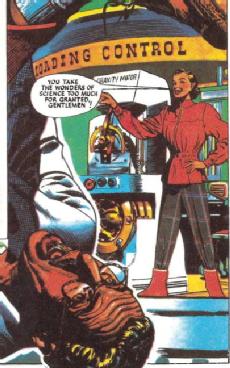 We currently know of no way to manipulate gravity, to generate it or to direct it as we wish. All science fictional explanations are vague at best, as was the case for Colin Kapp’s 1961 short story “For the Love of Pete” in which anti-gravity relied on psionic abilities the protagonist could neither control nor believe in. However this vagueness doesn’t prevent a huge range of science fiction narratives from assuming that artificial gravity will be a solved problem in any future that involves interstellar spaceflight. The many examples include Thunderbirds (in which Thunderbirds 3 and 5 appear to have artificial gravity), Star Trek (where different incarnations have discussed gravity plating and graviton stabilisers), the Sector General hospital of James White’s novels (where gravity can be adjusted in individual sections to suit different life forms and habitat requirements) and Dan Dare (where Professor Peabody memorably once stopped a riot through use of an artificial gravity control in The Red Moon Mystery, comic,1953). It is also a typical feature of alien craft in science fiction, even in universes where humans are still restricted to using spin gravity - as seen for example in the Minbari ships of Babylon 5, which contrast with the rotating sections of Earth warships in the same serial. In this context it is used as a visual mechanism through which to humble the audience, emphasising the relative immaturity of our technology on a cosmic scale.
We currently know of no way to manipulate gravity, to generate it or to direct it as we wish. All science fictional explanations are vague at best, as was the case for Colin Kapp’s 1961 short story “For the Love of Pete” in which anti-gravity relied on psionic abilities the protagonist could neither control nor believe in. However this vagueness doesn’t prevent a huge range of science fiction narratives from assuming that artificial gravity will be a solved problem in any future that involves interstellar spaceflight. The many examples include Thunderbirds (in which Thunderbirds 3 and 5 appear to have artificial gravity), Star Trek (where different incarnations have discussed gravity plating and graviton stabilisers), the Sector General hospital of James White’s novels (where gravity can be adjusted in individual sections to suit different life forms and habitat requirements) and Dan Dare (where Professor Peabody memorably once stopped a riot through use of an artificial gravity control in The Red Moon Mystery, comic,1953). It is also a typical feature of alien craft in science fiction, even in universes where humans are still restricted to using spin gravity - as seen for example in the Minbari ships of Babylon 5, which contrast with the rotating sections of Earth warships in the same serial. In this context it is used as a visual mechanism through which to humble the audience, emphasising the relative immaturity of our technology on a cosmic scale.
More practicality, and particularly in visual media, such artificial gravity is a common feature of science fiction to avoid the constant requirement for explanations, avoid the jarring unfamiliarity of low-gravity motion which would otherwise distract the audience, and, above all, avoid the practical complexity of simulating a zero-gravity or micro-gravity environment on Earth-gravity-bound sets.
It should be noted that, in the event of faster-than-light travel ever becoming plausible (a paradigm-breaking impossibility in current physics) then artificial gravity would become a necessity even for short journeys in space - there is no other way to compensate for the bone-shattering accelerations such travel would require. For the moment, though, true artificial gravity remains well beyond human reach. Despite the recent discovery of the Higgs boson, and confirmation of Einsteinian General Relativity in the form of gravitational waves, our understanding of gravity remains at an early stage. Its manipulation would require not only enormous technical innovation, but also an equally enormous paradigm shift in our understanding of Physics.
Given our evolution deep in Earth’s gravitational well, it is perhaps no wonder that gravity is essential for the long term operation of our bodies, and artificial gravity is a major preoccupation of science fiction writers. Of all the mechanisms currently available to us, one of the first to be recognised - spin gravity - remains the most plausible for use in human space habitation. However the length scales needed for a comfortable environment remain well beyond any practical and economic construction we can currently envisage. As a result, space is likely to remain an environment of microgravity for the foreseeable future.
“Artficial Gravity”, Elizabeth Stanway, Cosmic Stories blog. 13th August 2023.
Notes:
[1] Gravity itself is a huge topic - more than enough for several blog entries - so I’m going to keep the focus fairly narrow in this entry and concentrate on specific examples relating to apparent gravity in artificial human environments rather than the subject in general. [Return to text]
[2] Gravity features in several other ways in the film Interstellar - which I'll come back to another time. [Return to text]
All views expressed in this blog entry reflect those of the author and not necessarily those of the University of Warwick. All images sourced online and used here under fair-use provisions for commentary and criticism.
